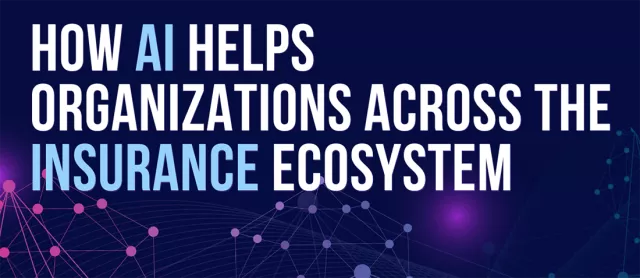There is no human equivalent to the speed at which artificial intelligence (AI) can inspect large datasets, determine patterns, predict potential outcomes, and streamline processes through automation. Businesses can unlock the door to analytical insights when they use data and AI to drive activities such as underwriting and claims processing and influence decision-making. Ultimately, this will make an organization more adaptable to market conditions and more responsive to consumer needs.
For example, as explored in the blog 3 Use Cases for AI in Insurance, when AI algorithms can better predict future claims and calculate associated risk, insurers can set more appropriate premium levels to not only avoid underpricing policies, which can lead to financial losses, but to also avoid overpricing that can result in lost business.
AI INTEGRATION IN ACTION — EXAMPLES OF DECISION-MAKING PROCESS IMPROVEMENTS
Organizations across the insurance ecosystem — carriers, MGAs, TPAs, risk pools, self-insureds, and others — can harness the power of AI to improve decision-making processes. AI can help:
-
Rate the severity of a claim and call attention to claims that are more likely to be complex or costly.
-
Extract data and supply the information in a more readable format that pinpoints key data for adjusters.
-
Map client data based on information provided, giving a baseline assessment of clients.
-
Rate medical providers using data such as treatment date, each provider involved, and the diagnosis given.
-
Help assess data throughout the lifespan of claims to rank risk, evaluate the potential of a lawsuit, and predict total incurred losses.
-
Provide auto underwriting support through risk ranking and loss projection.
-
Provide workers’ compensation underwriting support using payroll codes, loss projection, and risk ranking data.
-
Rate legal counsel — both on the defense and plaintiff sides — based on how they’ve performed historically using input from both the client’s and internal data.
-
Meet regulatory guidelines by scanning medical records, automatically extracting applicable data, and culling that information into reports.
BRIDGING THE GAP — EVALUATING CORE INSURANCE SYSTEMS
To make these types of analytical insights possible, insurers must first evaluate the technologies they have in place or the degree to which those technologies integrate with one another. Unfortunately, insurance companies often have in place a myriad of systems with outdated technology. These systems typically leave data isolated in silos, are expensive to maintain, and contribute to subpar user experiences. Flexible, modern core systems, on the other hand, enable insurers to access their data in real time. They can also be integrated with third-party AI technologies through custom application program interfaces (APIs).
Internal and external resources, along with partners that have knowledge of an insurer’s systems and data, are critical to AI implementation, especially in the early stages. Partnering with different AI providers can help bridge the gap between what’s possible today and what’s going to be necessary to push the envelope tomorrow.
For further information on how insurers can clean up their organizations’ data to make way for AI, read our “Get Your House In Order For…AI” e-book.

